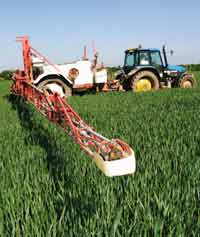Resistant wheats fall victim to yellow rust

Watch out for yellow rust even on new wheat varieties considered resistant, a consultant to the breeder of Viscount has warned.
Last winter’s frosts were expected to have put a lid on significant rust outbreaks this season, except possibly in the highly susceptible variety Robigus, says agronomist Bob Simons.
But the disease’s presence on Solstice (Arable, 8 May), formerly resistant to all known yellow rust races, and more recently its discovery in several untreated trials of KWS’s Viscount and Nickerson variety Qplus was unexpected, said Mr Simons.
“The level of yellow rust attack and geographic spread has surprised some agronomists and pathologists.”
Whether the new race infecting Solstice is also responsible for the latest findings remained to be seen.
“We don’t know much about the impact of the ‘Solstice’ race yet,” said NIAB pathologist Rosemary Bayles. “But it’s a complex type and more virulent than previous ones such as the Madrigal race and the Robigus one that’s dominant at the moment.
“We’ve been surprised at how well yellow rust survived the winter,” added Dr Bayles. “It seems that once it gets into a leaf it can withstand quite low temperatures.”
Mr Simons speculated that last year’s late harvest had led to an enhanced “green bridge”, which had increased rust inoculum levels and created more pressure on crops. Disrupted spraying programmes with many T0 treatments being omitted had all worked in the disease’s favour, he believed.
“We know that wet autumns and anything that encourages the green bridge has quite an effect on rust levels in the following growing season,” added Dr Bayles.
The implications for field control were quite simple, said Mr Simons.
“The best flag leaf strategy for susceptible varieties, especially in areas where an attack has been recorded, is for sprays to be based on a triazole with strong septoria and rust activity combined with a rust-active strob.
“This triazole/strob combination will give more prolonged protection than triazole alone and, especially if the strob is pyraclostrobin, give better control of brown rust which sits patiently in the wings.”
A top-up of rust control at T3 would be needed, he believed.
Mr Simons said it was likely that some of this season’s attempts to get good field control of yellow rust would fail through omission of T0 treatments, poor T1 or T2 timings or failure to use a triazole/strob mix at flag leaf.
“This may lead to adverse comments. There’s no doubt that yellow rust historically brings with it a big fear factor and the simple solution has been to drop the variety.
“It’s vital that farmers quantify the risk and keep it in context rather than adopting an overly extreme reaction and potentially discarding the best performing wheats on the farm.”

